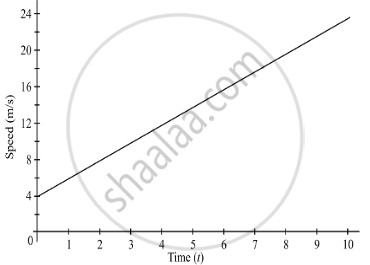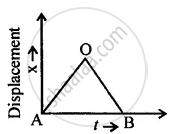Advertisements
Advertisements
Question
A car is moving on a straight road with uniform acceleration. The speed of the car varies with time as follows :
Time (s) : 0 2 4 6 8 10
Speed (m/s) : 4 8 12 16 20 24
Draw the speed-time graph by choosing a convenient scale. From this graph :

(1) Calculate the acceleration of the car.
(2) Calculate the distance travelled by the car in 10 seconds.
Solution
We have a velocity-time graph of a moving particle.

(i) We have to find the acceleration from the given graph.
Acceleration = slope of line
= `((12-4))/((4-0)) "m/s"^2 = 2 "m/s"^2`
(ii) Distance travelled by the car is given by the area enclosed by the curve.
s = `"(Sum of parallel sides)(Height)"/2`
= `((4+24)(10))/2` m
= 140 m
APPEARS IN
RELATED QUESTIONS
What name is given to the speed in a specified direction ?
Name the physical quantity which gives us an idea of how slow or fast a body is moving.
Convert a speed of 54 km/h into m/s.
A car travels the first 30 km with a uniform speed of 60 km h-1 and the next 30 km with a uniform speed of 40 km h-1. Calculate :
The total time of journey,
The average speed of the car.
A train is moving with a velocity of 90 km h-1 . It is brought to stop by applying the brakes which produce a retardation of 0.5 ms-2 Find :
(i) The velocity after 10 s , and
(ii) the time taken by the train to come to rest .
What is the relation between distance and time when the body is moving with uniform velocity?
Draw a diagram to show the motion of a body whose speed remains constant, but velocity changes continuously.
A body projected vertically up with a velocity of 10 m/s reaches a height of 20 m. If it is projected with a velocity of 20 m/s, then the maximum height reached by the body is:
Write down the type of motion of a body along with the A – O – B of the following distance – time graph.

Distinguish between speed and velocity.
